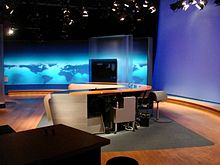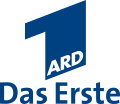Das Erste
| Das Erste | |
|---|---|
 | |
| Launched | 25 December 1952 (1952-12-25) |
| Owned by | ARD |
| Picture format | 1080p HDTV (downscaled to 16:9 576i for the SDTV feed) |
| Audience share | 11.6% (July 2018 (2018-07), KEK) |
| Country | Germany |
| Language | German |
| Broadcast area | Germany Austria Luxembourg Switzerland Liechtenstein Slovenia Belgium Italy (Friuli-Venezia Giulia) Netherlands Denmark Kosovo |
| Headquarters | Munich, Germany |
| Formerly called | NWDR-Fernsehen (1952-1954) Deutsches Fernsehen (1954-1984) Erstes Deutsches Fernsehen (1984-1997) |
| Website | www.daserste.de |
Availability | |
| Terrestrial | |
| Digital terrestrial television | Channel slots vary on each city |
| Satellite | |
Astra 19.2°E (Europe) | 11.836 GHz Horizontal SR: 27500 FEC: 3/4 SID: 28106 Video PID: 101 Audio PIDs: 102 stereo, 106 Dolby Digital |
| Astra 19.2°E (DVB-S2 HDTV) (Europe) | 11.494 GHz Horizontal SR: 22000 FEC: 2/3 SID: 10301 Video PID: 5101 Audio PIDs: 5102 stereo, 5106 Dolby Digital |
| Cable | |
| Kabel Deutschland | Channel 101 (SD) Channel 112 (HD) |
| Unitymedia | Channel 301 (SD) Channel 1 (HD) |
UPC Cablecom (Switzerland) | Channel 5 |
Naxoo (Switzerland) | Channel 153 |
Ziggo (Netherlands) | Channel 54 (HD) |
YouSee (Denmark) | Channel 91 (HD) |
| IPTV | |
| Telekom Entertain | Channel 1 (HD) |
A1 TV (Austria) | Channel 18 (SD) Channel 318 (HD) |
| Streaming media | |
| DasErste.de | Watch live |
| Ziggo GO | ZiggoGO.tv (Netherlands only) |
| Horizon | Horizon.tv (Switzerland only) |
Das Erste (German: [das ˈʔeːɐ̯stə], The first) is the principal publicly-owned television channel in Germany. It is a joint production of Germany's regional public broadcasters acting through, and coordinated by, the ARD consortium, with the exception of Deutsche Welle. The channel was officially launched on 25 December 1952 as NWDR-Fernsehen and renamed to Deutsches Fernsehen in 1954.[1] Since 1996, the official brand is Das Erste; the full name Erstes Deutsches Fernsehen (First German Television) is still used before every major news edition. In colloquial speech, the station is usually called Erstes Programm ("First Channel"), or by its metonym, ARD.
Contents
1 History
2 Member broadcasting organizations
2.1 Time assigned
3 Broadcasting
4 Logos
5 Programmes
5.1 Children
5.2 Entertainment
5.3 Information
5.4 Series
5.5 Sport
5.6 Talk
5.7 Former programmes
6 Audience share
6.1 Germany
7 References
8 External links
History

Studio of the news programme Tagesschau

The Maus, the popular children's series
The channel's first experimental broadcast was on 27 November 1950 as the TV channel of the then NWDR, which in 1956 split into NDR and WDR. The regular NWDR television service started on 25 December 1952. Nationwide transmission began on 1 November 1954 within the ARD framework, under the name Deutsches Fernsehen ("German Television"). It was West Germany's only television channel prior to the establishment of ZDF in 1963.[2]
The new channel consisted of jointly-produced shows such as the nightly news programme Tagesschau (on the air since 26 December 1952), as well as broadcasts produced individually by ARD member stations. The programs were coordinated by the Programmdirektion based in Munich. Besides several entertaining shows, ARD went political in 1957 when it launched its first political TV magazine, Panorama. Germany's first political TV show adopted the slogan "What is being talked about and what should be talked about" and pictured all aspects of postwar West German society—including conflict-laden topics, scandals, and other taboo topics, such as former Nazis who had held important roles.[3]
ARD nevertheless produced a provisional second TV channel from 1 June 1961 until ZDF started its transmissions on 1 April 1963. Colour television was introduced on 25 August 1967. From 1 September 1995 Das Erste broadcasts 24 hours a day.
The channel's name was changed to Erstes Deutsches Fernsehen ("First German Television") on 30 September 1984. Also around 1984, a new corporate design was introduced. The previous logo, with stylized waves, was replaced by a new logo showing a stylized number "1" which is still in use today. It changed its name to Das Erste in 1997, but the long name Erstes Deutsches Fernsehen is still used for some purposes (e.g. the introduction to the main editions of the Tagesschau). Informally, it is also known as ARD among viewers.
In addition to its SD broadcast, a 720p50 HD version of the channel, Das Erste HD, is also broadcast. Broadcast of Das Erste HD began in February 2010 with the coverage of the 2010 Winter Olympics in Vancouver, British Columbia, Canada.[4]Das Erste HD is available via satellite (DVB-S2 on Astra 19.2°E), cable (all cable providers in Germany and some providers throughout Europe), IPTV (Telekom Entertain) and DVB-T2 HD (here available in 1080p50).
Member broadcasting organizations
All nine of Germany's regional public-broadcasting organizations contribute to the output of Das Erste and broadcast its programming in a common schedule.
Time assigned
Each regional member of ARD (themselves informally referred to as "Die Dritten", "the Thirds") contributes programming to the channel's schedule in proportion to the population of the area it serves. As of February 2006, the time allocations as percentage shares of total broadcast hours were:[citation needed]
| Broadcasting organisation | % of total |
|---|---|
Bayerischer Rundfunk (BR) | 15.25 |
Hessischer Rundfunk (HR) | 7.35 |
Mitteldeutscher Rundfunk (MDR) | 11.45 |
Norddeutscher Rundfunk (NDR) | 17.45 |
Radio Bremen (RB) | 1.00 |
Rundfunk Berlin-Brandenburg (RBB) | 7.00 |
Saarländischer Rundfunk (SR) | 1.30 |
Südwestrundfunk (SWR) | 17.95 |
Westdeutscher Rundfunk (WDR) | 21.25 |
Broadcasting
Before 1990, Das Erste was only distributed in West Germany, and was almost exclusively broadcast using transmitters owned by the Deutsche Bundespost. However, the transmitters were powerful enough that Das Erste could easily be seen in nearly all of East Germany as well. Indeed, Das Erste's broadcasts, particularly its newscasts, were far more popular in East Germany than those of state broadcaster Deutscher Fernsehfunk. Exceptions included Dresden, located in a deep valley in southeastern East Germany, and the area around Rügen. One popular nickname for ARD in East Germany was Außer Rügen und Dresden (except Rügen and Dresden).

Areas with ARD and Das Erste reception in East Germany in gray with black areas having no reception (often jokingly referred to as Außer (except) Rügen und Dresden), and broadcasting transmitters near the inner German border.
On 15 December 1990 following reunification, programming from ARD was distributed by Deutsche Post of the GDR for the first time. The GDR-transmitters were later taken over by the Bundespost and merged organizationally with the West German transmitters. The transmitters of the Bundespost were transferred in 1995 to Deutsche Telekom, and then in turn to T-Systems.[5]
Between 2002 and 2008 the transmission facilities in Germany were successively converted from the analogue PAL standard to the new digital DVB-T standard.
Das Erste is available throughout Europe on free-to-air digital satellite television via Astra, as well as on many cable providers. Transmission via the Hot Bird satellite was stopped on 1 April 2017.
Logos

1970 - 1984

1984 - 1994

1994 - 2003

2003 - 2015

2003 - 2015

28 February 2015 – present

28 February 2015 – present

28 February 2015 – present
Programmes
Children
Frag doch mal die Maus (WDR), hosted by Eckart von Hirschhausen (2006–present)
Janoschs Traumstunde, children's programme (1986-1998)
Sesamstraße (NDR), children's programme
Die Sendung mit der Maus (WDR), children's programme
Entertainment
Alfons und Gäste (SWR/SR) (2008–present)
Die große Show der Naturwunder (SWR) (2006–present)
extra 3 (NDR), political satire
Gefragt - Gejagt, German version of The Chase (2015–present)
Immer wieder Sonntags (SWR) (1995–present)
Inas Nacht (NDR) (2009–present)
Musikantenstadl (co-production with ORF and SRF) (1983-2015)
Quizduell (NDR), hosted by Jörg Pilawa (2014–present)
Paarduell (WDR) (2016–present)
Spiel für dein Land - Das größte Quiz Europas (co-production with ORF and SRF), hosted by Jörg Pilawa (2015–present)
Verstehen Sie Spaß? (SDR/SWR), hosted by Guido Cantz (1980–present)
Information
ARD-Morgenmagazin (WDR) (1992–present)
ARD-Mittagsmagazin (BR) (1989–present)
Berliner Runde (SFB/RBB) (1999–present)
Bonner Runde (WDR) (1972-1999)
Brennpunkt (multiple) (1971–present)
Brisant (MDR) (1994–present)
Fakt (MDR) (1992–present)
Kontraste (SFB/RBB) (1968–present)
Monitor (WDR) (1965–present)
Nachtmagazin (ARD Aktuell, NDR) (1995–present)
Panorama (NDR) (1957–present)
Plusminus (multiple) (1975–present)
Presseschau (SFB) (1969-2002)
Report (Report Mainz/Report München) (SWF/SWR/BR) (1960–present)
Tagesschau (ARD Aktuell, NWDR/NDR) (1952–present)
Tagesthemen (ARD Aktuell, NDR) (1978–present)
Umschau (SFB/RBB/MDR) (1969-present)
Weltspiegel (multiple) (1963–present)
Series
Babylon Berlin (2018-present)
Blankenese (1994, 2001-2002, 2005)
Charité (2017)
Die Stein (2008, 2011)
Earth 2 (2008)
Falcon Crest (1983-1991)
Frau Temme sucht das Glück (2017)
Großstadtrevier (1986–present)
Heiter bis tödlich (multiple), light police comedy
In aller Freundschaft (MDR), weekly soap (1998–present)
In aller Freundschaft - Die jungen Ärzte (MDR), weekly soap (2015–present)
Kir Royal (1986-1990)
Lindenstraße (WDR), weekly soap (1985–present)
Magnum, P.I. (Magnum) (1984-1994)
Miami Vice (1986-1994)
Mord in bester Gesellschaft crime series (2007–present)
Murder, She Wrote (Mord ist ihr Hobby) (1988)
Polizeiruf 110 (multiple), crime drama
Rentnercops (2015–present)
Rote Rosen (Degeto Film), daily soap (2006–present)
Sturm der Liebe (BR), daily soap (2005–present)
Tatort (all regional stations)
Türkisch für Anfänger (2006–2009)
Um Himmels Willen (2002–present)
Vorstadtweiber (2015-2016)
Weissensee (2010, 2013, 2015)
Sport
Sportschau (on Saturdays with Bundesliga, WDR) (1961–present)
Sportschau vor acht (WDR) (2013–present)
Sportschau-Club (WDR) (2012–present)
Talk
Anne Will (NDR), hosted by Anne Will (2007–present)
Beckmann (NDR), hosted by Reinhold Beckmann (1999-2014)
Der internationale Frühschoppen (1953-1987)
Günther Jauch (NDR), hosted by Günther Jauch (2011-2015)
Hart aber fair (WDR), hosted by Frank Plasberg (2007–present)
Maischberger (RBB/WDR), hosted by Sandra Maischberger (2003–present)
Presseclub (WDR) (1987–present)
Sabine Christiansen (NDR), hosted by Sabine Christiansen (1998-2007)
Former programmes
- Beat-Club
Berlin, Berlin (SFB/RBB)
Echo Music Prize (1998-2000, 2009-2016)
Ein Herz und eine Seele (NDR)
Die Kommissarin (1994-2006)
Graf Yoster (1967-1976)
Harald Schmidt (WDR)
Marienhof (WDR), daily soap (1992-2009)- Musikladen
Polylux (ORB/RBB) (2000-2008)- Raumpatrouille
Verbotene Liebe (WDR), daily soap (1995-2015)
Wochenspiegel (ARD-aktuell, NWDR/NDR) (1953-2014)
Ziehung der Lottozahlen (HR), (1965–2013)
Germany
| January | February | March | April | May | June | July | August | September | October | November | December | Annual average | |
|---|---|---|---|---|---|---|---|---|---|---|---|---|---|
| 1990[6] | - | - | - | - | - | - | - | - | - | - | - | - | 30.8% |
| 1991[7] | - | - | - | - | - | - | - | - | - | - | - | - | |
| 1992[8] | - | - | - | - | - | - | - | - | - | - | - | - | |
| 1993[9] | - | - | - | - | - | - | - | - | - | - | - | - | |
| 1994[10] | - | - | - | - | - | - | - | - | - | - | - | - | |
| 1995[11] | - | - | - | - | - | - | - | - | - | - | - | - | |
| 1996[12] | 14.8% | 15.2% | 14.4% | 14.1% | 13.6% | 18.2% | 15.8% | 14.5% | 14.5% | 14.3% | 13.9% | 14.2% | |
| 1997[13] | 14.3% | 15.2% | 13.3% | 15.0% | 13.7% | 14.9% | 15.0% | 16.0% | 15.6% | 14.3% | 14.6% | 14.6% | |
| 1998[14] | 14.8% | 15.8% | 14.8% | 14.2% | 15.1% | 19.9% | 18.1% | 15.2% | 14.8% | 14.3% | 14.1% | 14.0% | |
| 1999[15] | 14.8% | 15.3% | 14.8% | 14.1% | 13.7% | 14.8% | 14.5% | 13.9% | 13.7% | 13.1% | 13.4% | 14.3% | |
| 2000[16] | 14.4% | 14.4% | 14.1% | 13.5% | 14.3% | 15.7% | 15.1% | 14.1% | 15.9% | 13.3% | 13.7% | 13.5% | |
| 2001[17] | 12.9% | 14.3% | 13.3% | 12.7% | 13.2% | 14.1% | 14.7% | 13.8% | 14.8% | 13.4% | 13.7% | 14.2% | |
| 2002[18] | 13.6% | 15.9% | 13.7% | 13.8% | 13.6% | 17.1% | 13.9% | 14.9% | 13.8% | 13.4% | 13.5% | 13.5% | |
| 2003[19] | 14.0% | 14.9% | 14.2% | 13.6% | 13.2% | 14.0% | 14.8% | 14.1% | 14.6% | 13.3% | 13.7% | 13.6% | |
| 2004[20] | 13.1% | 13.8% | 13.7% | 13.7% | 13.8% | 17.4% | 13.3% | 16.0% | 12.6% | 13.1% | 13.8% | 13.4% | |
| 2005[21] | 13.2% | 14.3% | 13.4% | 13.8% | 12.3% | 13.8% | 13.5% | 13.8% | 13.3% | 12.9% | 13.2% | 14.0% | |
| 2006[22] | 13.9% | 15.4% | 13.7% | 13.3% | 13.6% | 18.4% | 14.2% | 14.1% | 13.7% | 13.5% | 13.5% | 13.7% | |
| 2007[23] | 13.8% | 14.3% | 13.9% | 13.1% | 13.0% | 12.9% | 12.2% | 13.9% | 13.4% | 13.3% | 13.4% | 13.1% | |
| 2008[24] | 13.6% | 13.8% | 12.5% | 12.5% | 12.9% | 18.0% | 12.6% | 15.1% | 12.7% | 12.4% | 12.6% | 12.7% | 13.4% |
| 2009[25] | 12.5% | 13.3% | 13.1% | 12.7% | 12.5% | 12.5% | 12.0% | 13.1% | 12.6% | 12.7% | 12.8% | 12.5% | |
| 2010[26] | 13.4% | 14.0% | 12.8% | 12.8% | 12.9% | 17.1% | 14.0% | 12.2% | 12.5% | 11.9% | 12.2% | 12.7% | |
| 2011[27] | 12.5% | 12.9% | 13.2% | 12.6% | 12.8% | 13.1% | 12.1% | 12.3% | 11.8% | 11.8% | 11.6% | 11.9% | |
| 2012[28] | 12.9% | 11.8% | 12.2% | 11.2% | 11.2% | 15.9% | 11.4% | 13.5% | 11.5% | 11.7% | 11.7% | 12.2% | |
| 2013[29] | 12.2% | 12.4% | 12.5% | 12.1% | 11.7% | 12.3% | 11.7% | 12.0% | 12.0% | 11.7% | 11.7% | 12.3% | |
| 2014[30] | 11.7% | 13.4% | 12.3% | 11.4% | 12.0% | 17.4% | 15.0% | 11.3% | 11.3% | 11.1% | 11.8% | 11.5% | |
| 2015[31] | 11.3% | 11.8% | 11.6% | 12.2% | 11.8% | 12.1% | 10.9% | 11.2% | 10.9% | 11.2% | 11.9% | 11.9% | |
| 2016[32] | 12.2% | 11.6% | 11.3% | 11.5% | 12.1% | 16.0% | 13.1% | 14.0% | 11.0% | 10.7% | 11.2% | 11.2% | |
| 2017[33] | 10.6% | 11.8% | 12.0% | 11.8% | 11.4% | 10.7% | 10.7% | 11.0% | 11.2% | 10.9% | 11.3% | 11.8% | |
| 2018 |
The average age of the viewers is 61 years (as of 2016).[34]
References
^ "ARD-Pressemitteilung: 50 Jahre Erstes Deutsches Fernsehen - Symposium und Sondersendungen zum ARD-Jubiläum". presseportal.de. Retrieved 2016-06-12..mw-parser-output cite.citation{font-style:inherit}.mw-parser-output q{quotes:"""""""'""'"}.mw-parser-output code.cs1-code{color:inherit;background:inherit;border:inherit;padding:inherit}.mw-parser-output .cs1-lock-free a{background:url("//upload.wikimedia.org/wikipedia/commons/thumb/6/65/Lock-green.svg/9px-Lock-green.svg.png")no-repeat;background-position:right .1em center}.mw-parser-output .cs1-lock-limited a,.mw-parser-output .cs1-lock-registration a{background:url("//upload.wikimedia.org/wikipedia/commons/thumb/d/d6/Lock-gray-alt-2.svg/9px-Lock-gray-alt-2.svg.png")no-repeat;background-position:right .1em center}.mw-parser-output .cs1-lock-subscription a{background:url("//upload.wikimedia.org/wikipedia/commons/thumb/a/aa/Lock-red-alt-2.svg/9px-Lock-red-alt-2.svg.png")no-repeat;background-position:right .1em center}.mw-parser-output .cs1-subscription,.mw-parser-output .cs1-registration{color:#555}.mw-parser-output .cs1-subscription span,.mw-parser-output .cs1-registration span{border-bottom:1px dotted;cursor:help}.mw-parser-output .cs1-hidden-error{display:none;font-size:100%}.mw-parser-output .cs1-visible-error{font-size:100%}.mw-parser-output .cs1-subscription,.mw-parser-output .cs1-registration,.mw-parser-output .cs1-format{font-size:95%}.mw-parser-output .cs1-kern-left,.mw-parser-output .cs1-kern-wl-left{padding-left:0.2em}.mw-parser-output .cs1-kern-right,.mw-parser-output .cs1-kern-wl-right{padding-right:0.2em}
^ "Jahresrückblick 1952: Neues Rundfunkhaus in Lokstedt". tagesschau. Retrieved 2016-06-12.
^ "60 Jahre ARD - Ein "Dinosaurier" und seine Zukunft". Norddeutscher Rundfunk. Retrieved 2016-06-12.
^ "HDTV im Ersten". daserste.de. Archived from the original on 3 March 2010. Retrieved 2 March 2010.
^ "Chronik der ARD". ARD. Retrieved 2016-06-12.
^ "KEK/Zuschaueranteile 1990" (PDF). kek-online.de. Archived from the original (PDF) on 8 December 2015. Retrieved 30 June 2017.
^ "KEK/Zuschaueranteile 1991" (PDF). kek-online.de. Archived from the original (PDF) on 8 December 2015. Retrieved 30 June 2017.
^ "KEK/Zuschaueranteile 1992" (PDF). kek-online.de. Archived from the original (PDF) on 8 December 2015. Retrieved 30 June 2017.
^ "KEK/Zuschaueranteile 1993" (PDF). kek-online.de. Archived from the original (PDF) on 8 December 2015. Retrieved 30 June 2017.
^ "KEK/Zuschaueranteile 1994" (PDF). kek-online.de. Archived from the original (PDF) on 8 December 2015. Retrieved 30 June 2017.
^ "KEK/Zuschaueranteile 1995" (PDF). kek-online.de. Archived from the original (PDF) on 8 December 2015. Retrieved 30 June 2017.
^ "KEK/Zuschaueranteile 1996" (PDF). kek-online.de. Retrieved 30 June 2017.
^ "KEK/Zuschaueranteile 1997" (PDF). kek-online.de. Retrieved 30 June 2017.
^ "KEK/Zuschaueranteile 1998" (PDF). kek-online.de. Retrieved 30 June 2017.
^ "KEK/Zuschaueranteile 1999" (PDF). kek-online.de. Retrieved 30 June 2017.
^ "KEK/Zuschaueranteile 2000" (PDF). kek-online.de. Retrieved 30 June 2017.
^ "KEK/Zuschaueranteile 2001" (PDF). kek-online.de. Retrieved 30 June 2017.
^ "KEK/Zuschaueranteile 2002" (PDF). kek-online.de. Retrieved 30 June 2017.
^ "KEK/Zuschaueranteile 2003" (PDF). kek-online.de. Archived from the original (PDF) on 11 August 2017. Retrieved 30 June 2017.
^ "KEK/Zuschaueranteile 2004" (PDF). kek-online.de. Archived from the original (PDF) on 11 August 2017. Retrieved 30 June 2017.
^ "KEK/Zuschaueranteile 2005" (PDF). kek-online.de. Retrieved 30 June 2017.
^ "KEK/Zuschaueranteile 2006" (PDF). kek-online.de. Retrieved 30 June 2017.
^ "KEK/Zuschaueranteile 2007" (PDF). kek-online.de. Retrieved 30 June 2017.
^ "KEK/Zuschaueranteile 2008" (PDF). kek-online.de. Retrieved 30 June 2017.
^ "KEK/Zuschaueranteile 2009" (PDF). kek-online.de. Retrieved 30 June 2017.
^ "KEK/Zuschaueranteile 2010" (PDF). kek-online.de. Retrieved 30 June 2017.
^ "KEK/Zuschaueranteile 2011" (PDF). kek-online.de. Retrieved 30 June 2017.
^ "KEK/Zuschaueranteile 2012" (PDF). kek-online.de. Archived from the original (PDF) on 11 August 2017. Retrieved 30 June 2017.
^ "KEK/Zuschaueranteile 2013" (PDF). kek-online.de. Archived from the original (PDF) on 4 March 2016. Retrieved 30 June 2017.
^ "KEK/Zuschaueranteile 2014" (PDF). kek-online.de. Retrieved 30 June 2017.
^ "KEK/Zuschaueranteile 2015" (PDF). kek-online.de. Archived from the original (PDF) on 17 May 2017. Retrieved 30 June 2017.
^ "KEK/Zuschaueranteile 2016" (PDF). kek-online.de. Retrieved 30 June 2017.
^ "KEK/Zuschaueranteile 2017" (PDF). kek-online.de. Retrieved 30 January 2018.
^ Mantel, Uwe (14 March 2017). "Langzeit-Entwicklung des TV-Markts: Wie die Sender gealtert sind - und wer sich dagegen stemmt". dwdl.de. Retrieved 3 November 2017.
External links
Official website (in German)
DasErste Mediathek (VoD Portal) (in German)
| Wikimedia Commons has media related to Das Erste. |






